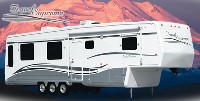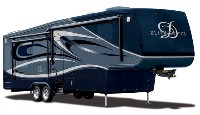The scarcest statement I can hear from an uninformed RVer with a fifth-wheel (FW) trailer is
“my truck can easily pull my trailer.” Why, because pulling should be one of the last
considerations for selecting a truck.
See A Sad Story for what can happen.
So what are the important considerations for selecting a FW
tow vehicle? First, we should start with some terms:
 |
 |
| GAW |
Gross Axle Weight – the maximum weight that axle can hold |
| GVW |
Gross Vehicle Weight - the total of the weight on the axles, the weight of the vehicle on the ground. In
the case of a trailer, the axle weight plus the weight being transferred to the tow vehicle |
| GVWR |
Gross Vehicle Weight Rating – the maximum weight the vehicle can weigh |
| UVW |
Unloaded Vehicle Weight – the weight of the vehicle as built, empty |
| NCC |
Net Carry Capacity – usually the difference between GVWR and UVW |
| GCW |
Gross Combined Weight – the combined weight of the tow vehicle and the vehicles being towed |
| GCWR |
Gross Combined Weight Rating – the maximum combined weight of the tow vehicle and the vehicles being towed |
We will be using the term Dually pickup to mean the top end of the weight class for the pickup brand with dually wheels for
extra weight capacity.
Now, here are some specifications on Dually crewcab pickup trucks
with diesel, automatic, and 8’ beds.
 |
 |
 |
 |
| Lbs. |
Chevrolet
3500HD
2013 |
Ford
F350SD
2013 |
Ram
3500
2013 |
| GVW |
13,000 |
14,000 |
14,000 |
| Curb Weight |
7,552 |
6,560 |
7,960 |
| Net Cargo Cap |
4,028 |
6,020 |
6,040 |
| Max 5th W Trailer Weight |
28,500 |
22,800 |
29,370 |
| GCWR |
30,500 |
33,000 |
37,500 |
We should note that in many states, a truck over 10,000 GVWR is considered a commercial vehicle (no matter how it is used)
which affects license plates and insurance.
Not only are the manufacturers vague in publishing weight numbers (this is
getting better), but they also hedge on what they do say. For
example, the following is a direct quote from Ford’s RV And Trailer Towing Guide for 2007.
“Maximum Loaded Trailer Weight is the highest possible
weight of a fully loaded trailer the vehicle can tow, based
on a minimum towing vehicle GVW. It assumes a towing vehicle
with any mandatory options, no cargo, tongue load of 10-15%
(conventional trailer) or king pin weight of 15-25%
(fifth-wheel trailer), and driver only (150 lbs.). F-Series
Super Duty chassis cab models also assume a second-unit body
weight of 1,000 lbs. Weight of additional options,
passengers, cargo, and hitch must be deducted from this
weight.
Gross Combined Vehicle Rating view
Let’s determine the actual trailer capacity from the maximum weight pulled:
 |
 |
 |
 |
| Lbs. |
Chevrolet
3500HD
2013 |
Ford
F350SD
2013 |
Ram
3500
2013 |
| Curb Weight |
7,552 |
6,560 |
7,960 |
| Add fuel, passengers, some stuff |
1,420 |
1,420 |
1,420 |
| GCWR |
30,500 |
33,000 |
37,500 |
| Remaining Trailer weight |
21,003 |
16,431 |
15,860 |
| Maximum 5th Wheel by Manufacturer |
21,500 |
25,000 |
28,100 |
Gross Vehicle Rating view
Now let’s determine the actual trailer capacity from the view of what the maximum trailer pin weight can be. Normally the
trailer pin weight should be around 20% to 25% of the total trailer weight so we could say the trailer can be up to five
times the pin weight up to the limit of the GCWR of the truck. We will use 20% for comparisons.
 |
 |
 |
 |
| Lbs. |
Chevrolet
3500HD
2013 |
Ford
F350SD
2013 |
Ram
3500
2013 |
| Curb Weight |
7,552 |
6,560 |
7,960 |
| Add fuel, passengers, some stuff |
1,420 |
1,420 |
1,420 |
| GVWR |
13,000 |
13,000 |
11,500 |
| Remaining Trailer Pin weight |
4,028 |
4,931 |
4,620 |
| Effective Trailer Weight |
20,100 |
30,100 |
23,100 |
| Maximum 5th Wheel by Manufacturer |
28,500 |
22,800 |
29,370 |
The added "some stuff" includes things like; spare tire (an option), your weight, your mate,
extra fuel tank, and tools.
General observations: Dodge RAM is overstating their
trailer capabilities, Chevrolet and Ford are understating them.
Now, a listing of the weight of the trailers we are considering remembering that the tow vehicle has to be qualified
from a GCWR and a GVWR aspect:
 |
 |
 |
 |
 |
|
GVWR |
Pin Weight* |
| Carriage |
18,600 |
3,000 |
| King of the Road |
20,000 |
3,100 |
| New Horizons |
21,000 |
3,190 |
 |
Newmar Kountry Aire |
20,000 |
3,100 |
| NuWa Hitchhiker |
17,900 |
3,200 |
| Teton |
20,000 |
2,900 |
| Travel Supreme |
19,900 |
2,600 |
|
*Note these are from the manufacturer. As a reference, out Travel Supreme weighed in
with a pin weight of 4,500 as built and loaded |
We should note that the above values were from manufacturer brochures. The pin weights listed appear to be with a
trailer as delivered. A lot of the load you will add to the trailer will be in the cargo bay and the closets, all adding
more weight to the pin weight. We should note that the specs above are for trucks that have heavier capacities than
previous Dually truck capacities.
In the years we have been doing this research, we have observed the weights capacities of pickups rising, each in response to the
others increases. But we have seen a increases in engine capacities, and transmission capacities. But what is the real issue is not GVWR or GCWR, because you
can see these FW trailers being towed by Dually pickups all the time? The issue is the stopping and handling capacity of the
truck. A major improvement we have observed is that all three manufacturers are installing exhaust brakes in their diesel pickups.
When we first started looking at RVs, we were open to fifth-wheel (FW) trailers and motorhomes. At the first RV
show, we were in a National Seabreeze FW and the dealer rep asked what we would pull it with. I indicated that I had a
Chevrolet Silverado ¾ ton 4x4. The rep said that if I did it right, I would have to get a Medium Duty Truck (MDT).
The next year I spent time researching MDTs and came to respect the reason the rep told me why I would need a MDT for
the size trailer we had been talking about. The next show I asked the same dealer rep what prompted him to get a MDT and
he replied, “The second time my trailer pushed my pickup through an intersection.”
Most people look at the horsepower as the big issue and have felt that, with the new diesels that Ford, Chevrolet
and Dodge Ram are using, they can easily pull big trailers even up hills. But can the pickup control the combined vehicle weight, when
steering and braking? Pulling a heavy trailer with a pickup means you are over-stressing the truck. Things will
break. Expensive things like the transmissions.
There are many add-ons to increase the horsepower of the engine. But the frame and the brakes are as they come, and
even the transmission does not have capacity increasing add-ons.
Example: For years, Dodge detuned the Cummins engine because it native torque rating exceeded the transmission
rating. Then people would go out and use chips and other performance enhancements to
restore and increase the Cummins
horsepower, all over the transmission rating.
If you ever plan to travel in the mountains, the drive trains of these pickups, even with tow mode transmissions, will require
you use your brakes to control your speed downhill. Compare that to a tow vehicle with an engine brake where engine
braking is used to control downhill speeds leaving your brakes for emergencies.
Probably the biggest reason to be concerned about having a properly sized tow vehicle is the litigious world we live in.
If you get involved in an accident, even one that was not your fault, and you are over-weight, you are severely exposed to
legal action. To start, the authorities may choose to cite you for operating an unsafe vehicle. Then your insurance
company can choose to not cover you. And finally, there is always a lawyer looking to get money from someone who was in the
wrong. See A Sad Story.
Some Canadian Provinces and a few states are starting to stop and check the weights of RV rigs to see if they are within the
GVWR and GCWR ratings of the vehicles.
Conclusion
So, if a Dually is marginally up to the job of pulling a heavy FW trailer, what do you need? The answer is a
Medium Duty Truck (MDT).
|

